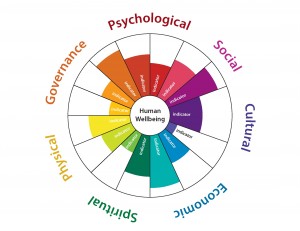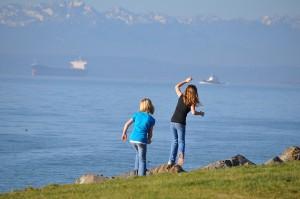State approves human wellbeing indicators for Puget Sound
Puget Sound Partnership Leadership Council Chair Martha Kongsgaard calls it “the Holy Grail” of ecosystem-based management. It is the grand question. The ‘why.’
Puget Sound Partnership Leadership Council Chair Martha Kongsgaard calls it “the Holy Grail” of ecosystem-based management. It is the grand question. The ‘why.’
Why preserve Puget Sound in the first place?
Citizens and policymakers ask and answer that question every day, at least indirectly. “Any of the schemes we use to recover and restore Puget Sound are value-laden,” says Kongsgaard. “Every law that we have on the books is a reflection of community values.” But social scientists say our understanding of those values is often reflected more in politics than in science. They argue that by studying our relationship to Puget Sound, we can make better decisions about how to protect it.

A “medicine wheel” graphic that will be used to showcase HWB indicators; copyright Biedenweg et al.
This week the Puget Sound Partnership adopted 23 wellbeing indicators designed to gauge that relationship. They range from economic wellbeing to social and emotional benefits like happiness. All will be incorporated into the Puget Sound Partnership’s Human Quality of Life ‘Vital Sign.’ The indicators are based on research led by EoPS contributor Kelly Biedenweg of the University of Washington Puget Sound Institute. You can read more about Biedenweg's research on EoPS.
The power of indicators, say social scientists, is that you can measure them. Although it is a new concept in the United States, the indicators take inspiration from other efforts such as the Canadian Index of Wellbeing, which monitors wellbeing as an analogue to that country’s Gross National Product.
While quantifying things like happiness and beauty may seem unusual, Biedenweg says that understanding how we are affected by the environment is one of the keys to ecosystem recovery. People tend to engage more in positive, less destructive behaviors when they feel that they are receiving a benefit, she says. In turn, studies show that a healthy environment also leads to healthier—and happier—citizens.
Kongasgaard agrees. “It’s the quantifiable,” she says, “but it’s also the ineffable. What is the value of sharing these waters with orca and Chinook? What is the value of softening a bulkhead for the sake of a forage fish? What’s the value of a sunrise over Mount Baker?”
Indicators may never answer questions like those directly, but Biedenweg hopes that they may give policymakers and managers better tools for understanding the role of humans in the ecosystem. No small consideration as Puget Sound’s population edges past 4 million people.
Related:
Recent blog posts
PSI eNews Archives

This Encyclopedia's parent organization, the Puget Sound Institute, also publishes an email newsletter. Visit the PSI blog to subscribe to the PSI eNews or peruse past issues.






